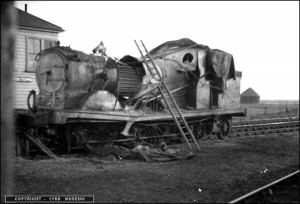By Jim Hollands
On the morning of 27 November 1942 an English train driver and a German pilot set off to work. By the end of the day one of them would be dead!
The Englishman, Charles Gilbert, took charge of his train in Ashford and set out on what he thought would be a normal day’s journey on the Southern Railway network.
The German, Heinz Bierwirth, climbed into his Focke-Wulf 190 at Abberville – Drucat, headed on a wartime ‘sweep’ over Kent. He was accompanied by one other aircraft from his Squadron which was part of the Luftwaffe JG26 Group. Their target was Ashford Railway works. which they were ordered to strafe and cannon shell, plus any other railway targets they passed over. Heinz had been with his Squadron for several months and as he passed from the French coast out over the English Channel he may well have been thinking back to the 19 August when he was the first German Pilot to claim a victory on the day of the Dieppe Raid. It was a Spitfire he claimed to have shot down on that fateful morning. He may also have been pondering on a day exactly two months before, on the 27 September, when he had his first ‘confirmed’ kill, another Spitfire brought down 10k N.W. of Calais. His thoughts would have been brought back into sharp focus as Hythe and the English Coast loomed ahead.
As they crossed the town they fired a burst, probably at the RH&DR station, and killed a man when one of the shells exploded in his front room. Then on, over the hill to Sellindge, where they strafed the Ever Ready Service Station, (now Bob Fisher’s Car Sales Garage). Then to Smeeth where damage was inflicted on rail track and Up & Shunt signals were destroyed.
Ashford Railway Works came in range of the marauders and a locomotive was attacked in the Down Sidings. The fireman was injured. Another loco was also hit, this time the fireman was killed. A man in a nearby office was struck in the chest by a cannon shell. A farm at Kingsnorth was attacked, a farmer was hit in the leg and a sheep killed.
Meanwhile Charles Gilbert in Tank Engine No.2365 was travelling towards Lydd at a sedate pace of 25mph when Heinz Bierwirth banked his aircraft and dived towards it. Shells and bullets poured into the engine, steam shot into the footplate area, badly scalding the fireman. The pressure blew the locomotive boiler apart, it tore away the chimney, dome and safety valves. The dome landed in a field 100 metres away. The explosion was so powerful it propelled a portion of the top rim of the chimney almost a quarter of a mile.
At the precise moment the boiler exploded Heinz Bierman’s aircraft was passing overhead. Tank Engine No.2365 got it’s revenge on the Focke Wulf for the terrible damage it had suffered. It was also some kind of poetic justice that the Railway worker killed at Ashford was avenged by a railway engine that had set off from that same yard.
The fireman of the loco was taken to hospital suffering from steam scalds, the driver was shocked but uninjured.
An eyewitness saw the pilot, still in his seat, fall into a nearby field. Heinz Bierwirth was buried with military honours at Hawkinge Cemetery
A local newspaper reported that it was the New Romney line’s most famous day when a train brought down an enemy fighter! On 27th November 1942 a train hauled by an ex-LBSCR D3 class locomotive was attacked by a low-flying German fighter aircraft. A cannon shell from the ‘plane burst the D3’s boiler just as the plane flew 20 feet above. The plane crashed, the pilot was killed whilst the train and driver survived! The loco was rebuilt and back in service by 11th March.
After the war, traffic continued to decline and in 1962 British Railways replaced the steam hauled trains with two-car diesel-electrics. Goods services to New Romney ceased in 1964. The line was a prime candidate for closure under the Beeching “Axe” and despite appeals the last passenger trains ran on 6 March 1967 and the line, which opened for passenger traffic in 1884 continued with a goods only service to Lydd. This was discontinued in 1971. Nonetheless, the line is still in use by the nuclear power station, Dungeness B to transport nuclear waste.
The level crossings are now un manned, operated by train crews, and all the surplus track has been removed. The line through Lydd to the power station loading site is still in place, as are the station buildings at Brookland and Lydd itself, both in private hands.
The extension of the runway at Lydd Airport may well mean the return of passenger air flights on a large scale. If this comes about, it is conceivable that the line may be updated and opened to passenger traffic directly from London to an Airport Station.
Ryes Own January 2015
Acknowledgements:-
Wikipedia; Jagdgeschwader 26; sussexhistoryforum; picture courtesy Lydd Museum
All material and Photographs included on the “Rye’s Own” website are subject to strick worldwide copyright

